Assessing Undergraduate Students’ e-Learning Competencies: A Case Study of Higher Education Context in Indonesia
Abstract
1. Introduction
- What is the level of student preparedness to study online in the higher education context in Indonesia during a pandemic?
- Are there any significant differences in student readiness to learn online during pandemics based on the year of study, the field of study, the level of e-learning culture at a university, student gender, and region?
2. Literature Review
2.1. E-Learning Types and Implementation
2.2. Student Preparedness
2.3. Factors Affecting Online Learning Implementation
3. Method
3.1. Context of the Study
3.2. Instrumentation
- E-Learning management and e-learning environment, 24 items.
- Interaction with teaching materials, 13 items.
- Interaction with e-learning community, 21 items.
4. Results
- The outfit mean square (MNSQ) value is in the range 0.5 < MNSQ < 1.5.Using this first requirement, two items were misfit, namely item A6 (learning/working in a disciplined and scheduled manner) and item B3 (presenting content in various formats (video, audio, etc.)). The outfit MNSQ values for the two items were 1.82 and 1.52.
- The outfit z-standard (ZSTD) value is in the range −2.0 < ZSTD < +2.0.The ZSTD value is greatly affected by sample size. In this study, the sample size was large enough that the ZSTD value was always above 3. Therefore, this condition was not used as a reference in this study.
- The point mean correlation (Pt Mean Corr) value is in the range 0.4 < Pt Mean Corr < 0.85.The instrument met the third requirement, there being no items that had a Pt Mean Corr value under 0.4 or over 0.85. All items were eligible to be used for measurement.
5. Findings and Discussion
6. Conclusions
Author Contributions
Funding
Institutional Review Board Statement
Informed Consent Statement
Data Availability Statement
Conflicts of Interest
References
- Hapsari, S.M.; Sugito, S.; Fauziah, P.Y. Parent’s involvement in early childhood education during the covid-19 pandemic period. J. Progress. Educ. 2020, 10, 298–311. [Google Scholar] [CrossRef]
- Aliyyah, R.R.; Rachmadtullah, R.; Samsudin, A.; Syaodih, E.; Nurtanto, M.; Tambunan, A.R.S. The perception of primary school teachers of online learning during the covid-19 pandemic period: A case study in Indonesia. J. Ethn. Cult. Stud. 2020, 7, 90–109. [Google Scholar]
- Asvial, M.; Mayangsari, J.; Yudistriansyah, A. Behavioral intention of e-learning: A case study of distance learning at a junior high school in Indonesia due to the covid-19 pandemic. Int. J. Technol. 2021, 12, 54–64. [Google Scholar] [CrossRef]
- Ariyanti, G.; Santoso, F.G.I. Analysis of mathematics learning outcomes on senior high school student in Madiun city, Indonesia in covid-19 pandemic. J. Phys. Conf. Ser. 2020, 1663, 1–6. [Google Scholar] [CrossRef]
- Rahiem, M.D.H. The emergency remote learning experience of university students in Indonesia amidst the covid-19 crisis. Int. J. Learn. Teach. Educ. Res. 2020, 19, 1–26. [Google Scholar] [CrossRef]
- Atmojo, S.E.; Muhtaro, T.; Lukitoaji, B.D. The level of self-regulated learning and self-awareness in science learning in the covid-19 pandemic era. J. Pendidik. IPA Indones. 2020, 9, 512–520. [Google Scholar]
- Ministry of Education and Culture of Republic of Indonesia. SE Mendikbud: Pembelajaran Secara Daring Dan Bekerja Dari Rumah Untuk Mencegah Penyebaran Covid-19. Available online: https://www.kemdikbud.go.id/main/blog/2020/03/se-mendikbud-pembelajaran-secara-daring-dan-bekerja-dari-rumah-untuk-mencegah-penyebaran-covid19 (accessed on 19 June 2020).
- Dwiyanti, K.E.; Pratama, I.P.Y.; Manik, N. Online learning readiness of junior high school students in Denpasar. Indones. J. Engl. Educ. 2020, 7, 172–188. [Google Scholar]
- Joosten, T.; Cusatis, R. Online learning readiness. Am. J. Distance Educ. 2020, 34, 180–193. [Google Scholar] [CrossRef]
- Hung, M.; Chou, C.; Chen, C.; Own, Z. Learner readiness for online learning: Scale development and student perceptions. Comput. Educ. 2010, 55, 1080–1090. [Google Scholar] [CrossRef]
- Chung, E.; Noor, N.M.; Mathew, V.N. Are you ready? An assessment of online learning readiness among university students. Int. J. Acad. Res. Progress. Educ. Dev. 2020, 9, 302–317. [Google Scholar]
- Kaymak, Z.D.; Horzum, M.B. Relationship between online learning readiness and structure and interaction of online learning students. Educ. Sci. Theory Pract. 2013, 13, 1792–1797. [Google Scholar]
- Engin, M. Analysis of students’ online learning readiness based on their emotional intelligence level. Univers. J. Educ. Res. 2017, 5, 32–40. [Google Scholar] [CrossRef]
- Yilmaz, R. Exploring the role of e-learning readiness on student satisfaction and motivation in flipped classroom. Comput. Hum. Behav. 2017, 70, 251–260. [Google Scholar] [CrossRef]
- Bovermann, K.; Weidlich, J.; Bastiaens, T. Online learning readiness and attitudes towards gaming in gamified online learning–A mixed methods case study. Int. J. Educ. Technol. High. Educ. 2018, 15, 1–17. [Google Scholar] [CrossRef]
- Kirmizi, O. The influence of learner readiness on student satisfaction and academic achievement in an online program at higher education. Turk. Online J. Educ. Technol. 2015, 14, 133–142. [Google Scholar]
- Parkes, M.; Reading, C.; Stein, S. The competencies required for effective performance in a university e-learning environment. Australas. J. Educ. Technol. 2013, 29, 777–791. [Google Scholar] [CrossRef]
- Director General of Higher Education; Ministry of Education and Culture of the Republic of Indonesia. Buku Pendidikan Tinggi Di Masa Pandemi Covid-19: Pembelajaran Perguruan Tinggi Dan Implementasi Merdeka Belajar Di Masa Pandemi Covid-19; Direktorat Jenderal Pendidikan Tinggi Kementerian Pendidikan dan Kebudayaan RI: Jakarta, Indonesia, 2020.
- Islam, S. Kesiapan belajar mandiri mahasiswa UT dan siswa SMA untuk belajar dengan sistem pendidikan tinggi terbuka dan jarak jauh di Indonesia. J. Pendidik. Terbuka Dan Jarak Jauh 2010, 11, 1–14. [Google Scholar]
- Puspitasari, K.A.; Listyarini, S. E-learning readiness of distance learners. Asean J. Open Distance Learn. 2018, 10, 62–71. [Google Scholar]
- Junus, K.; Sadita, L.; Santoso, H.B.; Soeradijono, S.H.; Suhartanto, H. Assessing students’ e-learning competencies in online learning environment. In Proceedings of the International Conference on Advanced Computer Science and Information Systems (ICACSIS), Bali, Indonesia, 28–29 October 2017; pp. 489–494. [Google Scholar]
- Larasati, C. Baru 20 Perguruan Tinggi Terapkan e-Learning. Available online: https://www.medcom.id/pendidikan/news-pendidikan/8kowxwWk-baru-20-perguruan-tinggi-terapkan-e-learning (accessed on 18 June 2020).
- Suri, A.; Subagyo, F.A.K.D.; Irwansyah, I. Computer-mediated communication dan manajemen kesan pada pembelajaran elektronik mahasiswa di masa pandemi covid-19. J. Sos. Dan Budaya Syar-i 2021, 8, 89–108. [Google Scholar]
- Maudiarti, S. Penerapan e-learning di perguruan tinggi. Perspekt. Ilmu Pendidik. 2018, 32, 53–68. [Google Scholar] [CrossRef]
- Koagouw, M.O. Breaking News: WHO Akhirnya Tetapkan Covid-19 Sebagai Pandemik. Available online: http://rri.co.id/post/berita/799731/internasional/breaking_news_who_akhirnya_tetapkan_covid19_sebagai_pandemik.html (accessed on 18 June 2020).
- WHO. WHO Characterizes COVID-19 as A Pandemic. Available online: https://www.who.int/emergencies/diseases/novel-coronavirus-2019/events-as-they-happen (accessed on 18 June 2020).
- Widodo, A.; Nursaptini, N.; Novitasari, S.; Sutisna, D.; Umar, U. From face-to-face learning to web base learning: How are student readiness? Prem. Educ. J. Pendidik. Dasar Dan Pembelajaran 2020, 10, 149–160. [Google Scholar]
- Meladina, M.; Zaswita, H. Shedding light of EFL students’ readiness and problems to face online learning in the pandemic era. Tamaddun Life J. Bhs. Sastra Dan Budaya 2020, 19, 1–8. [Google Scholar]
- Sulistyohati, A. Pengukuran e-learning readiness pada mahasiswa sebagai upaya penerapan pembelajaran jarak jauh masa pandemi covid-19. Edumatic J. Pendidik. Inform. 2020, 4, 136–145. [Google Scholar] [CrossRef]
- Goyal, S. E-learning: Future of education. J. Educ. Learn. 2012, 6, 239–242. [Google Scholar] [CrossRef]
- Rao, P. E-learning in India: The role of national culture and strategic implications. Multicult. Educ. Technol. J. 2011, 5, 129–150. [Google Scholar] [CrossRef]
- Zoroja, J.; Skok, M.M.; Bach, M.P. E-Learning implementation in developing countries: Perspectives and obstacles. In Online Tutor 2.0: Methodologies and Case Studies for Successful Learning; García-Peñalvo, F.J., Pardo, A.M.S., Eds.; IGI Global: Hershey, PA, USA, 2014; pp. 97–118. [Google Scholar]
- Octaberlina, L.R.; Muslimin, A.I. EFL students perspective towards online learning barriers and alternatives using moodle/google classroom during covid-19 pandemic. Int. J. High. Educ. 2020, 9, 1–9. [Google Scholar] [CrossRef]
- Wahyuningtyas, N.; Zainul, R.; Adri, M.; Wedi, A.; Surahman, E.; Aisyah, E.N.; Adnan, E. Development of moodle-based content learning system in MKDK student development subjects at LPTK in Indonesia. J. Phys. Conf. Ser. 2020, 1594, 1–10. [Google Scholar]
- Wiradharma, G. Google classroom or moodle? University student satisfaction in distance learning communication during covid-19 pandemic. J. Komun. Dan Bisnis 2020, 8, 85–99. [Google Scholar]
- Haqien, D.; Rahman, A.A. Pemanfaatan zoom meeting untuk proses pembelajaran pada masa pandemi covid-19. Sap. Susunan Artik. Pendidik. 2020, 5, 51–56. [Google Scholar]
- Febriyanti, R.H.; Sundari, H. Platform for application of use in online english based teaching. Rangkiang J. Pengabidan Pada Masy. Up3m Stkip Pgri Sumat. Barat 2020, 2, 17–27. [Google Scholar]
- Situmorang, A.S. Microsoft teams for education sebagai media pembelajaran interaktif meningkatkan minat belajar. Serpen J. Math. Educ. Appl. 2020, 2, 30–35. [Google Scholar]
- Rojabi, A.R. Exploring EFL Students’ perception of online learning via Microsoft Teams: University level in Indonesia. Engl. Lang. Teach. Educ. J. 2020, 3, 163–173. [Google Scholar] [CrossRef]
- Arkorful, V.; Abaidoo, N. The role of e-learning, the advantages and disadvantages of its adoption in higher education. Int. J. Educ. Res. 2014, 2, 397–410. [Google Scholar]
- Moreno-Guerrero, A.-J.; Aznar-Díaz, I.; Cáceres-Reche, P.; Alonso-García, S. E-learning in the teaching of mathematics: An educational experience in adult high school. Mathematics 2020, 8, 840. [Google Scholar] [CrossRef]
- Omidinia, S.; Masrom, M.; Selamat, H. Review of e-learning and ICT infrastructure in developing countries (case study of Iran). Am. J. Econ. Bus. Adm. 2011, 3, 120–125. [Google Scholar] [CrossRef]
- Bhuasiri, W.; Xaymoungkhoun, O.; Zo, H.; Rho, J.J.; Ciganek, A.P. Critical success factors for e-learning in developing countries: A comparative analysis between ICT experts and faculty. Comput. Educ. 2012, 58, 843–855. [Google Scholar] [CrossRef]
- Mutisya, D.N.; Makokha, G.L. Challenges affecting adoption of e-learning in public universities in Kenya. E-Learn. Digit. Media 2016, 13, 140–157. [Google Scholar] [CrossRef]
- Kusumo, N.S.A.M.; Kurniawan, F.B.; Putri, N.I. E-Learning Obstacle Faced by Indonesian Students. In Proceedings of the Eighth International Conference on e-Learning for Knowledge-Based Society, Bangkok, Thailand, 23–24 February 2012; pp. 1–4. [Google Scholar]
- Aboderin, O.S. The challenges and prospects of e-learning in National Open University of Nigeria. J. Educ. Learn. 2015, 9, 207–216. [Google Scholar] [CrossRef]
- Adams, D.; Sumintono, B.; Mohamed, A.; Noor, N.S.M. E-learning readiness among students of diverse backgrounds in a leading Malaysian higher education institution. Malays. J. Learn. Instr. 2018, 15, 227–256. [Google Scholar]
- Blankenship, R.; Atkinson, J.K. Undergraduate student online learning readiness. Int. J. Educ. Res. 2010, 5, 44–54. [Google Scholar]
- Ünal, Y.; Alır, G.; Soydal, İ. Students readiness for e-learning: An assessment on Hacettepe University Department of Information Management. In Challenges of Information Management Beyond the Cloud; Gathegi, J.N., Tonta, Y., Kurbanoğlu, S., Al, U., Taşkın, Z., Eds.; Springer: Berlin/Heidelberg, Germany, 2014; Volume 423, pp. 137–147. [Google Scholar]
- Suwarsono, L.W. Pengukuran e-learning readiness pada mahasiswa teknik Universitas Telkom. PsympathicJ. Ilm. Psikol. 2015, 2, 141–152. [Google Scholar] [CrossRef]
- The, M.M.; Usagawa, T. A comparative study of students’ readiness on e-learning education between Indonesia and Myanmar. Am. Sci. Res. J. Eng. Technol. Sci. 2018, 40, 113–124. [Google Scholar]
- Firdaus, F.; Muntaqo, R.; Trisnowati, E. Analysis of student readiness for blended learning model implementation in industrial era 4.0. Indones. J. Sci. Educ. 2020, 4, 48–56. [Google Scholar] [CrossRef]
- Ramadiani, R.; Azainil, A.; Hidayanto, A.N.; Khairina, D.M.; Jundillah, M.L. Teacher and student readiness using e-learning and m-learning. Bull. Electr. Eng. Inform. 2020, 9, 1176–1182. [Google Scholar] [CrossRef]
- Purwandani, I. Analisa tingkat kesiapan e-learning (e-learning readiness), studi kasus: AMIK Bina Sarana Informatika Jakarta. J. Bianglala Inform. 2017, 5, 102–107. [Google Scholar]
- Mahardika, E.K.; Ningtyas, D.P. Analisis kesiapan mahasiswa FKIP Universitas Terbuka Malang dalam pembelajaran berbasis e-learning sebagai dampak pandemi virus covid-19. J. Caksana: Pendidik. Anak Usia Dini 2020, 3, 1–9. [Google Scholar]
- Saintika, Y.; Astiti, S.; Kusuma, D.J.A.; Muhammad, A.W. Analysis of e-learning readiness level of public and private universities in Central Java, Indonesia. Regist. J. Ilm. Teknol. Sist. Inf. 2021, 7, 15–30. [Google Scholar] [CrossRef]
- Ramadan, R.; Pradnyana, I.M.A.; Suyasa, P.W.A. Pengukuran tingkat kesiapan implementasi e-learning (e-learning readiness) di SMAN2 Singaraja menggunakan model chapnick. J. Pendidik. Teknol. Dan Kejuru. 2019, 16, 258–266. [Google Scholar] [CrossRef]
- Cuadrado-García, M.; Ruiz-Molina, M.; Montoro-Pons, J.D. Are there gender differences in e-learning use and assessment? Evidence from an interuniversity online project in Europe. Procedia Soc. Behav. Sci. 2010, 2, 367–371. [Google Scholar] [CrossRef]
- Elango, R.; Gudep, V.K.; Selvam, M. Quality of e-learning: An analysis based on e-learners’ perception of elearning. Electron. J. E-Learn. 2008, 6, 31–44. [Google Scholar]
- Pingle, S.S. Higher education student readiness for e-learning. Technolearn Int. J. Educ. Technol. 2011, 1, 155–165. [Google Scholar]
- Johnson, R.D. Gender differences in e-learning: Communication, social presence, and learning outcomes. J. Organ. End User Comput. 2011, 23, 79–94. [Google Scholar] [CrossRef]
- Morante, A.; Djenidi, V.; Clark, H.; West, S. Gender differences in online participation: Examining a history and a mathematics open foundation online course. Aust. J. Adult Learn. 2017, 57, 266–293. [Google Scholar]
- Fojtik, R. Comparison of full-time and distance learning. In Proceedings of the 4th World Conference on Educational Technology Researches, Procedia-Social and Behavioral Sciences, Barcelona, Spain, 28–29 November 2014; Volume 182, pp. 402–407. [Google Scholar]
- Ngampornchai, A.; Adams, J. Students’ acceptance and readiness for e-learning in Northeastern Thailand. Int. J. Educ. Technol. High. Educ. 2016, 13, 1–13. [Google Scholar] [CrossRef]
- Wang, S.; Iwata, J.; Jarrell, D. Exploring Japanese students’ e-learning habits. Jalt Call J. 2018, 14, 211–223. [Google Scholar] [CrossRef]
- Hosseini, S.Y.; Salimifard, K.; Yadollahi, S. On the effects of organizational culture on e-learning readiness: An Iranian experience. Int. J. Soc. Ecol. Sustain. Dev. 2012, 3, 42–52. [Google Scholar] [CrossRef]
- Alshaher, A.A. The Mckinsey 7s model framework for e-learning system readiness assessment. Int. J. Adv. Eng. Technol. 2013, 6, 1948–1966. [Google Scholar]
- Shahmoradi, L.; Changizi, V.; Mehraeen, E.; Bashiri, A.; Jannat, B.; Hosseini, M. The challenges of e-learning system: Higher educational institutions perspective. J. Educ. Health Promot. 2018, 7, 1–6. [Google Scholar]
- Thakkar, S.; Joshi, H. Students’ attitude towards e-learning. Int. J. Adv. Eng. Res. Dev. 2017, 4, 209–213. [Google Scholar]
- Elnakeeb, M.; Khalifa, S.M.A. The relationship between online learning readiness and social interaction anxiety among nursing students in Alexandria University. World J. Nurs. Sci. 2016, 2, 140–152. [Google Scholar]
- Asfar, N.; Zainuddin, Z. Secondary students’ perceptions of Information, Communication and Technology (ICT) use in promoting self-directed learning in Malaysia. Online J. Distance Educ. E-Learn. 2015, 3, 67–82. [Google Scholar]
- PDDIKTI. Higher Educational Statistical Years Book; Kementerian Riset Teknologi Dan Pendidikan Tinggi Indonesia. Available online: https://pddikti.kemdikbud.go.id/asset/data/publikasi/Statistik%20Pendidikan%20Tinggi%20Indonesia%202018.pdf (accessed on 28 July 2020).
- Yu, C.H. Objective measurement: How rasch modeling can simplify and enhance your assessment. In Rasch Measurement Application in Quantitative Educational Research; Khine, M.S., Ed.; Springer: Singapore, 2020; pp. 47–73. ISBN 978-981-15-1800-3. [Google Scholar]
- Khine, M.S. Objective measurement in psychometric analysis. In Rasch Measurement Application in Quantitative Educational Research; Khine, M.S., Ed.; Springer: Singapore, 2020; pp. 3–7. ISBN 978-981-15-1800-3. [Google Scholar]
- Sumintono, B.; Widhiarso, W. Aplikasi Pemodelan Rasch Pada Assessment Pendidikan; Trim Komunikata: Cimahi, Indonesia, 2015. [Google Scholar]
- Boone, W.J.; Staver, J.R.; Yale, M.S. Rasch Analysis in the Human Sciences; Springer: Dordrecht, The Netherlands, 2014. [Google Scholar]
- Khamparia, A.; Pandey, B. Impact of interactive multimedia in e-learning thechonogies: Role of multimedia in e-learning. In Enahncing Academic Research with Knowledge Management Principles; Deshpande, D.S., Bhosale, N., Londhe, R.J., Eds.; IGI Global: Hershey, PA, USA; pp. 199–227. ISBN 978-152-25-2489-2.
- Ramankulov, S.; Usembayeva, I.; Berdi, D.; Omarov, B.; Baimukhanbetov, B.; Shektivayev, N. Formation of the creativity of students in the context of the education informatization. Int. J. Environ. Sci. Educ. 2016, 11, 9598–9613. [Google Scholar]
- Lin, C.; Wu, R.Y. Effects of web-based creative teaching on students’ creativity and learning outcome. Eurasia J. Math. Sci. Technol. Educ. 2016, 15, 1675–1684. [Google Scholar] [CrossRef]
- Huertas-Bustos, A.; López-Vargas, O.; Sanabria-Rodríguez, L. Effect of a metacognitive scaffolding on information web search. Electron. J. E-Learn. 2018, 16, 91–106. [Google Scholar]
- Kim, M.; Hannafin, M. Scaffolding problem solving in technology-enhanced learning environments (TELEs): Bridging research and theory with practice. Comput. Educ. 2011, 56, 403–417. [Google Scholar] [CrossRef]
- Wood, D.; Bruner, J.; Ross, G. The role the tutoring in problem solving. J. Child Psychol. Psychiatry 1976, 17, 89–100. [Google Scholar] [CrossRef]
- Martha, A.S.D.; Santoso, H.B.; Junus, K.; Suhartanto, H. A scaffolding design for pedagogical agents within the higher-education context. In Proceedings of the 2019 11th International Conference on Education Technology and Computers (ICETC 2019), Amsterdam, The Netherlands, 28–31 October 2019; pp. 139–143. [Google Scholar]
- Laal, M.; Ghodsi, S.M. Benefits of collaborative learning. Procedia-Soc. Behav. Sci. 2012, 31, 486–490. [Google Scholar] [CrossRef]
- Razmerita, L.; Brun, A. Collaborative learning in heterogeneous classes. In Proceedings of the Third International Conference on Computer Supported Education (CSEDU 2011), Noordwijkerhout, The Netherlands, 6–9 May 2011; pp. 189–194. [Google Scholar]
- Gorgônio, F.L.; Vale, K.M.O.; Silva, Y.K.N.; Silva, H.M. Grouping students for cooperative and collaborative learning: Challenges and trends in virtual learning environments. In Proceedings of the IEEE World Engineering Education Conference, Santos, Brazil, 19–22 March 2017; pp. 51–55. [Google Scholar]
- Renes, S.L. Increasing Access to Higher Education Through E-Learning. In E-Learning-Instructional Design, Organizational Strategy and Management; Gradinarova, B., Ed.; IntechOpen: Rijeka, Croatia, 2015. [Google Scholar]
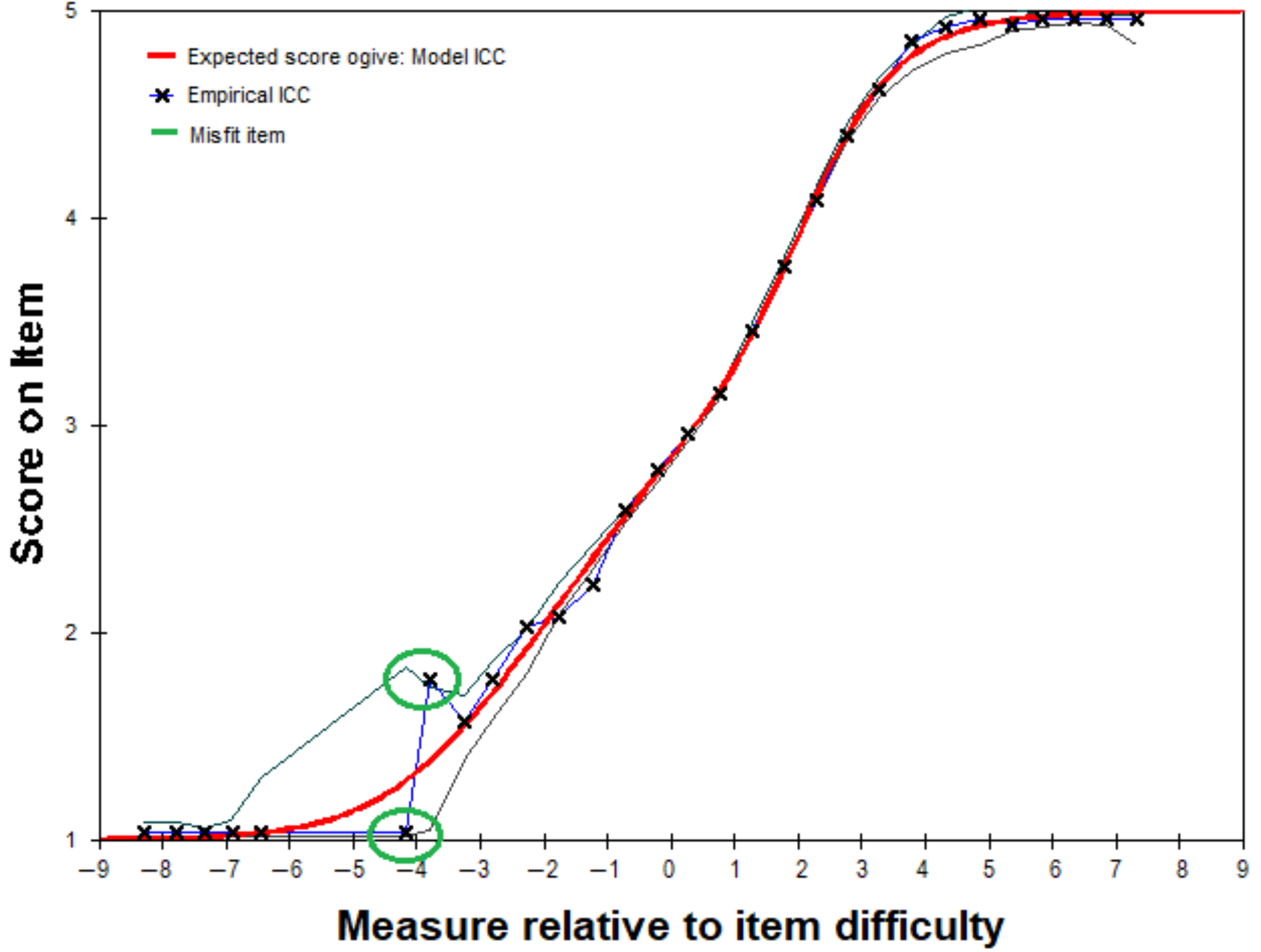
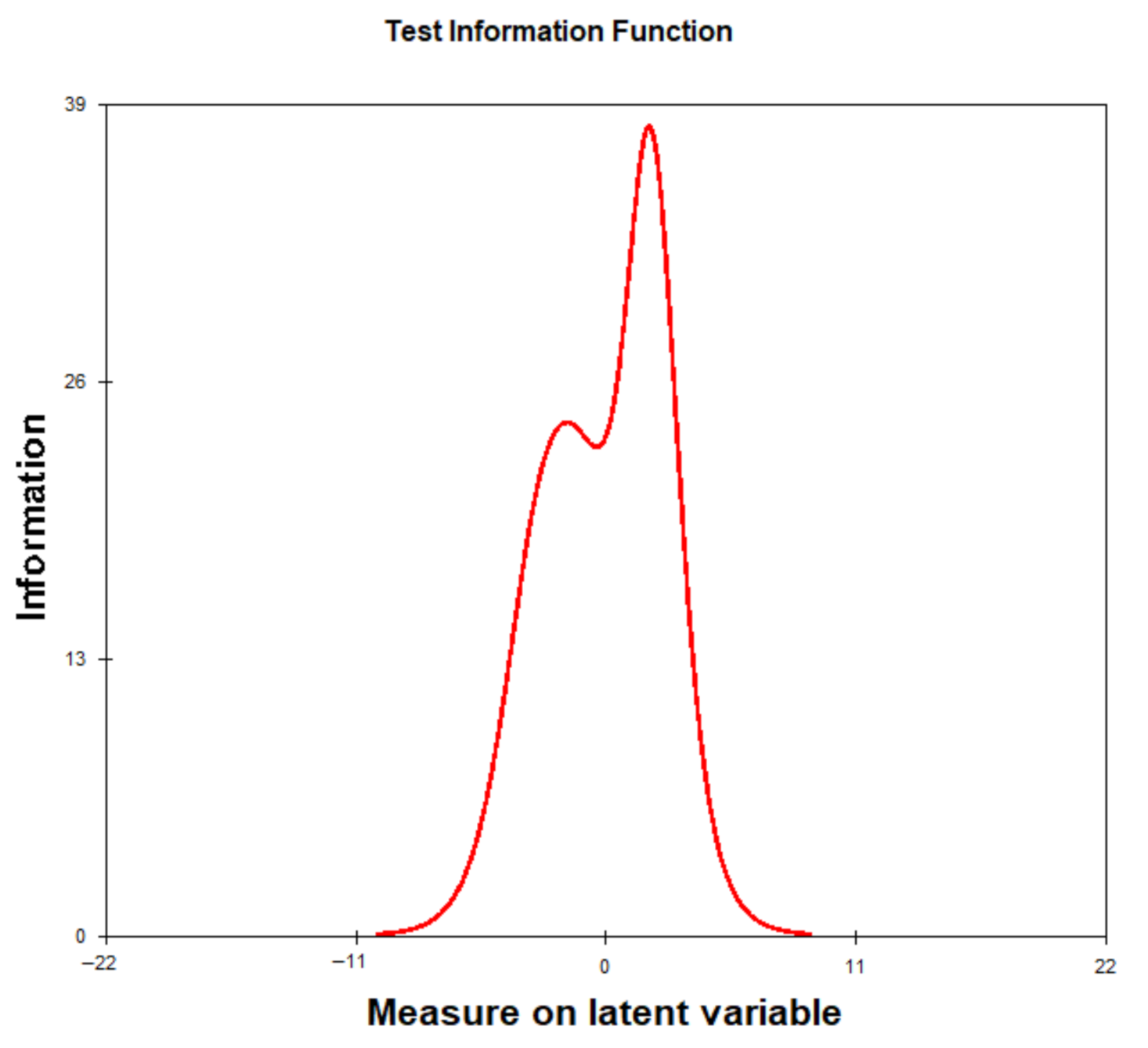
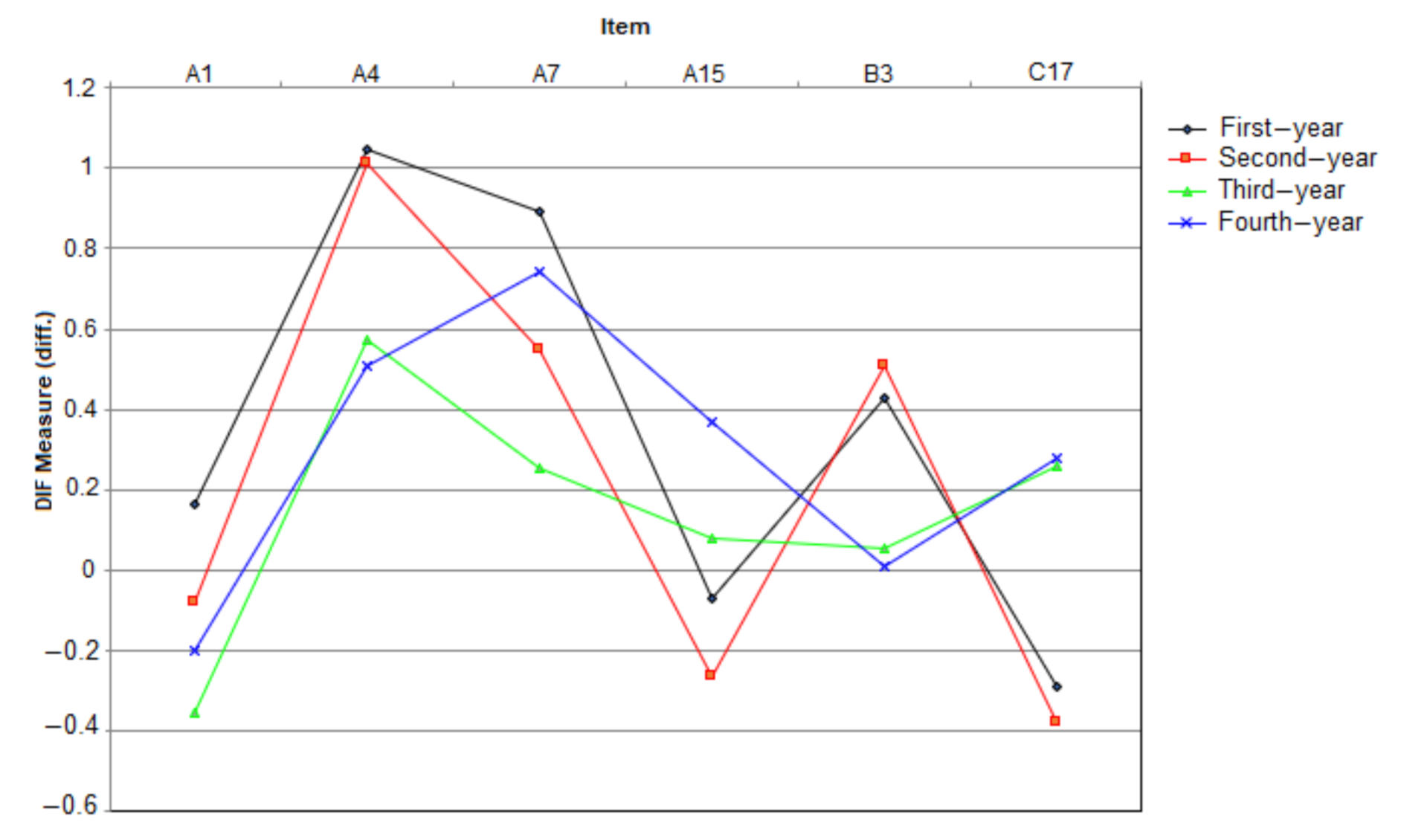


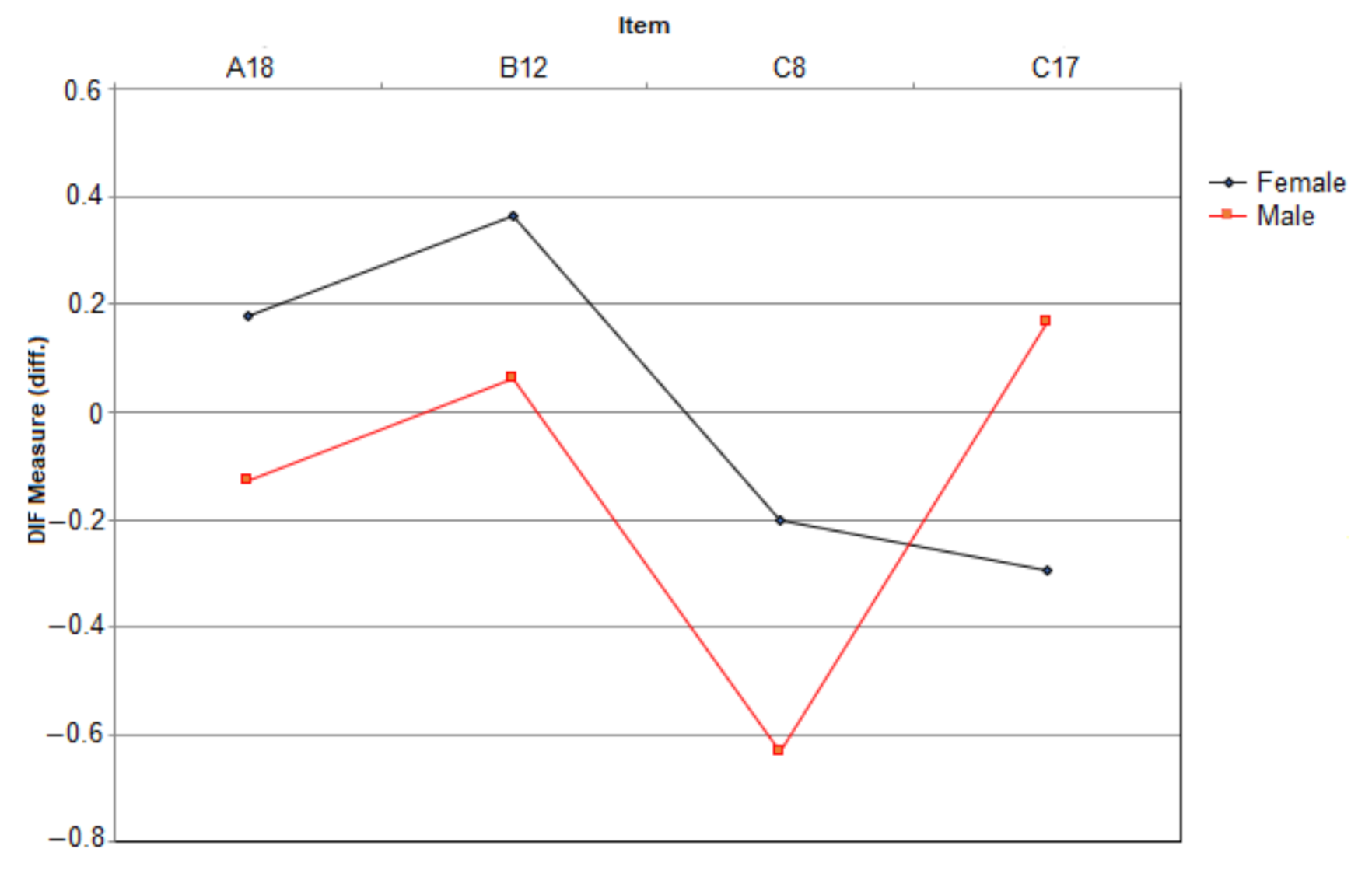
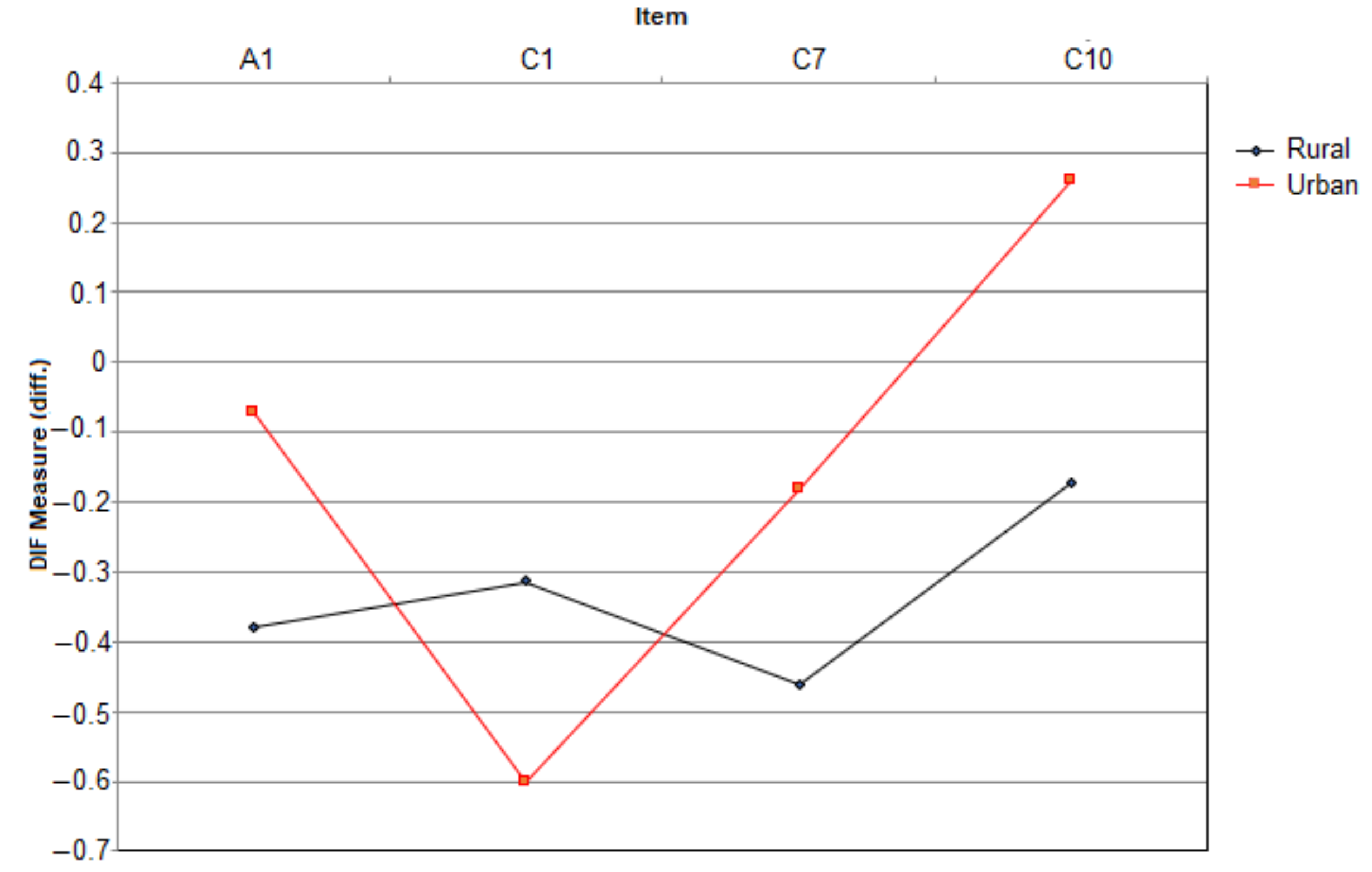
| Category | Total | Percentage (%) |
|---|---|---|
| Gender | ||
| Male | 336 | 69.71 |
| Female | 146 | 30.29 |
| Level of e-learning culture at the university | ||
| High | 117 | 24.27 |
| Middle | 57 | 11.83 |
| Low | 308 | 63.90 |
| Field of study | ||
| Economics | 30 | 6.22 |
| Sociology, politics, and humanities (SPH) | 17 | 3.53 |
| Education | 10 | 2.07 |
| Engineering | 397 | 82.37 |
| Health | 28 | 5.81 |
| Region | ||
| Urban | 286 | 59.34 |
| Rural | 196 | 40.66 |
| Year of study | ||
| First year | 78 | 16.18 |
| Second year | 114 | 23.65 |
| Third year | 241 | 50.00 |
| Four year | 49 | 10.17 |
| Age | ||
| 18 years and below | 31 | 6.43 |
| 19 years | 130 | 26.97 |
| 20 years | 136 | 28.22 |
| 21 years | 97 | 20.12 |
| 22 years | 51 | 10.58 |
| 23 years | 24 | 4.95 |
| 24 years and above | 13 | 2.70 |
| Mean Logit | Standard Deviation | Separation | Reliability | Cronbach’s Alpha | |
|---|---|---|---|---|---|
| Item | 0.00 | 0.41 | 5.98 | 0.97 | |
| Person | 0.99 | 1.20 | 5.33 | 0.97 | 0.97 |
| Mean | Standard Deviation | |
|---|---|---|
| E-learning competencies (overall) | +0.99 | 1.20 |
| E-learning management and e-learning environment | +0.96 | 1.36 |
| Interaction with teaching materials | +0.98 | 1.43 |
| Interaction with e-learning community | +1.29 | 1.56 |
Publisher’s Note: MDPI stays neutral with regard to jurisdictional claims in published maps and institutional affiliations. |
© 2021 by the authors. Licensee MDPI, Basel, Switzerland. This article is an open access article distributed under the terms and conditions of the Creative Commons Attribution (CC BY) license (https://creativecommons.org/licenses/by/4.0/).
Share and Cite
Martha, A.S.D.; Junus, K.; Santoso, H.B.; Suhartanto, H. Assessing Undergraduate Students’ e-Learning Competencies: A Case Study of Higher Education Context in Indonesia. Educ. Sci. 2021, 11, 189. https://doi.org/10.3390/educsci11040189
Martha ASD, Junus K, Santoso HB, Suhartanto H. Assessing Undergraduate Students’ e-Learning Competencies: A Case Study of Higher Education Context in Indonesia. Education Sciences. 2021; 11(4):189. https://doi.org/10.3390/educsci11040189
Chicago/Turabian StyleMartha, Ati Suci Dian, Kasiyah Junus, Harry Budi Santoso, and Heru Suhartanto. 2021. "Assessing Undergraduate Students’ e-Learning Competencies: A Case Study of Higher Education Context in Indonesia" Education Sciences 11, no. 4: 189. https://doi.org/10.3390/educsci11040189
APA StyleMartha, A. S. D., Junus, K., Santoso, H. B., & Suhartanto, H. (2021). Assessing Undergraduate Students’ e-Learning Competencies: A Case Study of Higher Education Context in Indonesia. Education Sciences, 11(4), 189. https://doi.org/10.3390/educsci11040189






